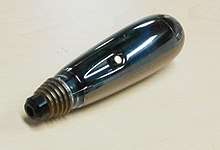Tullio Proni
Tullio John Proni (born 18 March 1948) is an American psychologist and artist, known for producing ray guns.

Early life and career
Proni, son of Oscar Proni and Maria Zampiera Proni, was born in Monfalcone, Italy. The family emigrated to the United States in June 1954, settling in Broward County, Florida.[1] Tullio Proni attended Nova High School in Davie. He later graduated from the University of Miami and worked briefly for Coulter Electronics in Hialeah, Florida.
Proni moved to Kalamazoo, Michigan for graduate study in experimental psychology at Western Michigan University. There, with his adviser Ronald R. Hutchinson, he participated in a research team investigating the measurement of human anger.[2] Proni undertook thesis work on the response of human subjects to varying rewards of money[3], receiving a master's degree in psychology in 1973.
He serves as Vice President and Information Technology Director[4] at the Foundation for Behavioral Resources, a nonprofit organization based in Augusta, Michigan that operates charter schools and daycare centers, among other activities.[5]With other inventors, he holds a patent on tracking the progress of students through a system of programmed classroom instruction.[6]
Ray guns and Isher Enterprises
In 1976 Proni, a skilled machinist, began fabricating "ray guns" resembling the futuristic handguns in illustrations of science fiction stories. A typical "weapon"—decorative but not functional—was fashioned from polished, transparent acrylic plastic, which acted as a light pipe for a pulsating colored bulb. Batteries and electronics were concealed in opaque parts such as the handgrip. Some models featured audio circuits and speakers to produce an eerie warbling tone.


Proni began attending science fiction conventions, selling these weapons in their dealers' rooms alongside booksellers and jewelry vendors. In time, other members of Proni's household assisted in manufacturing products he designed. Under the name of "Isher Enterprises," his tables offered a variety of products. handguns, larger weapons, and other handmade trinkets with flashing lights or bleeping sounds. He told the Battle Creek Enquirer: "Most of our artifacts are made from acrylic plastic, though we have literally used every material imaginable. Most of the artifacts are handguns which light up and make a ray gun sound. The light shines through the plastic, providing a translucent, icicle effect."[7]
Isher Enterprises took its name from the Weapon Shops of Isher series, science fiction stories by A. E. van Vogt. The business also adopted the motto of the fictional Weapon Shops, "The finest energy weapons in the known universe." In later years, the business adopted the name Isher Artifacts.[8]
The Isher table at conventions became a gathering point for other science fiction fans interested in technology. Proni collaborated on projects such as a remote-control robot fashioned from a cylindrical garbage can with a hemispherical top. With the release of Star Wars in 1977, public interest grew in ray guns and robots. Proni manufactured custom lightsabers. Artist Gordon Carelton said "He also made Artoo Detoo out of garbage cans. He took it to the premiere and got his picture in the papers." In Chicago, Proni was introduced to Star Wars actors Mark Hamill and Harrison Ford, then on a promotional tour.[9]
Isher continued to manufacture science-fictional weapons and props for several years, selling them at conventions and by mail order. Proni frequently introduced new, more sophisticated designs. As Chris Tower wrote in the Kalamazoo Gazette, "In stage one, he designs the gun, often on scraps of paper. In stage two, he figures out the lighting effects, mixing the integrated circuits, diodes, capacitors, resistors, and the like to get the sequencer and other effects to work. For step three, he constructs the body of the gun from aluminum, acrylic, brass, and Delrin [...] Then he tries to fit the circuit in the body casing, often 'an amusing step,' Tullio added."[8]
In 1993, a science fiction convention in the Chicago area, DucKon 4, invited Proni to be its Scientist Guest of Honor.[10]
Proni also co-founded General Technics, an organization of science fiction fans interested in do-it-yourself technology.[11]
Game design and other activities
In 1966 Proni designed War of the Empires, a play-by-mail space opera game, called by game designer Gary Gygax "possibly the earliest science fiction wargame."[12] Enticing prospective players, he wrote in an advertisement, "Leap into the future and command your own Space Navy! A small group is needed to defend Sol. Send qualifications but remember a good background in S. F. is needed."[13]
"Science-fiction fans will surely recognize here some trappings of A. E. van Vogt's Isher setting," wrote game historian Jon Peterson in 2018. War of the Empires provides a key example of the sorts of paper-and-pencil campaigns Gygax and others were playing in the years leading up to Dungeons & Dragons." In 1969, Gygax himself ran a revised version of Proni's game.[14] Proni has been involved in encouraging grade school students to explore science, founding an after-school model rocketry program.[15]
In 2002, Proni ran unsuccessfully as a Libertarian Party candidate for the Kalamazoo County Commission District 3.[16]
References
- Ranger, Amy (2005). "Proni Digital Library Collection 4: History". Proni Digital Library. Retrieved 2018-03-14.
- Hutchinson, R.R.; Pierce, G.E.; Emley, G.S.; Proni, T.J.; Sauer, R.A. (1977-12-01). "The laboratory measurement of human anger". Biobehavioral Reviews. 1 (4): 241–259. doi:10.1016/0147-7552(77)90026-2.
- Proni, Tullio J. (December 1973). The Effects of Changes in Response-Independent Pay upon Human Masseter EMG (PDF). Western Michigan University.
- "Tullio Proni". Relationship Science. Relationship Science. 2018-03-14. Retrieved 2018-03-14.
- "Foundation for Behavioral Resources". Foundation for Behavioral Resources. Foundation for Behavioral Resources. Retrieved 2018-03-14.
- US 8577280, Hutchinson, Ronald R.; Tullio J. Proni & Joseph V. Brady et al., "Programmed classroom instruction", published Aug 4, 2011, issued November 5, 2013
- Hare, Kevin (1993-06-06). "Beam me up, Scotty: Science fiction fans to convene". Battle Creek Enquirer. Battle Creek Enquirer. Retrieved 2018-03-15.
- Tower, Chris (1995-03-10). "Get ray guns here". Kalamazoo MI: Kalamazoo Gazette. pp. B6.
- Dana Felmly (1977-08-03). "Star warriors gird for future" (PDF). State News. Michigan State University. Retrieved 2018-03-15.
- Olson, Mark L. (2018-03-01). "Tullio Proni". Fancyclopedia 3. Retrieved 2018-03-14.
- "General Technics". Fancyclopedia 3. 2018-02-02. Retrieved 2018-03-15.
- Gygax, Gary (1976), "Does Anyone Remember War of the Empires?" (PDF), The Dragon (3): 4–5, retrieved 2018-03-14
- Peterson, Jon (2018-01-25). "War of the Empires (1969), Gygax's Space Conquest Campaign". Playing at the World. Retrieved 2018-03-15.
- Gygax, Gary (1969), "Infiltrators Report", The General, p. 15, retrieved 2018-03-14
- Grap, John (2008-04-03). "Mission Control, We're Having Fun". Battle Creek Enquirer. Retrieved 2018-03-15.
- "Michigan Libertarian Candidates" (PDF). Libertarian Party of Michigan. Libertarian Party of Michigan. Retrieved 15 March 2018.